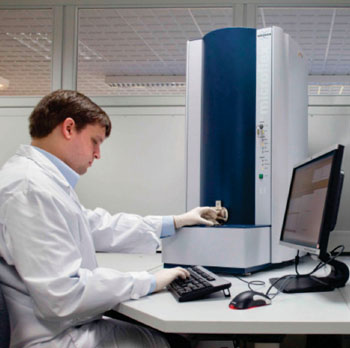Aerobic Bacteria Rapidly Identified by MALDI-TOF Mass Spectrometry
By LabMedica International staff writers
Posted on 27 Jan 2016
Matrix-assisted laser desorption ionization time-of-flight mass spectrometry (MALDI-TOF MS) is a diagnostic tool for the identification of organisms routinely found in the microbiology laboratory. Posted on 27 Jan 2016
MALDI-TOF MS has been proven to be a rapid and cost-effective diagnostic method for routine use in the clinical microbiology laboratory and MALDI-TOF MS technology uses ionizing laser for structural elements of the isolate to generate isolate-derived spectra, which is then compared to a reference database.
Scientists at the Children's Hospital Los Angeles (CA, USA) and their colleague at the Keck School of Medicine (Los Angeles, CA, USA) used isolates previously recovered by routine culture and workup from clinical specimens were cultured to appropriate media, identified directly by MALDI-TOF MS, and compared to results from various biochemical identification methods. A total of 996 aerobic Gram-positive and Gram-negative organism isolates were included in the study.
All MALDI-TOF MS testing was performed in duplicate with the same swab spotted onto two spots on the target plate, one spot representing a “heavy” inoculum and the second spot representing a “light” inoculum. Acquisition and analysis of mass spectra was performed using the Microflex LT mass spectrometer (Bruker Daltonics; Fremont, CA, USA). For media studies, 84 Gram-negative bacteria were cultured on blood agar, chocolate agar, and MacConkey agar; 74 Gram-positive bacteria were cultured on blood agar, chocolate agar, and colistin nalidixic acid (CNA) agar. For temperature and stability studies, four Gram-negative bacteria and four Gram-positive bacteria were cultured onto blood agar. Results of MALDI-TOF MS were compared to routine methods performed in the microbiology laboratory. All discordant identifications were confirmed by additional biochemical or 16S rRNA sequencing.
In MALDI-TOF MS data interpretation, a score of equal to or greater than 2.0 is equivocal to reliable species-level identification, a score of 1.7–1.99 is considered reliable to the genus level and a score of less than 1.7 is considered unreliable for bacteria identification. Using the direct-smear method, 99.5% and 98.0% of aerobic Gram-negative and Gram-positive bacteria, respectively, were identified to the genus level. At a score of equal to or greater than 1.9, 97.6% Gram-negative organisms and 94.6% Gram-positive organisms were correctly identified to the species level by direct-smear method. Only 1.1% of isolates required further reflex to direct-plate extraction. The direct-smear method proved to be robust, as various growth temperatures, media, culture age, and different operators had no notable impact on the bacterial identification rate.
The authors concluded that the direct-smear method was accurate and effective in streamlining the workflow of Gram-positive and Gram-negative bacterial identification in our clinical laboratory. For simplicity, they recommend using the direct-smear method for the majority of specimens commonly found in the clinical laboratory and an optimized spectral score cutoff of equal to or greater than 1.9 for enhanced species-level identification rates. The study was first published on December 14, 2015, in the Journal of Clinical Laboratory Analysis.
Related Links:
Children's Hospital Los Angeles
Keck School of Medicine
Bruker Daltonics









 assay.jpg)





